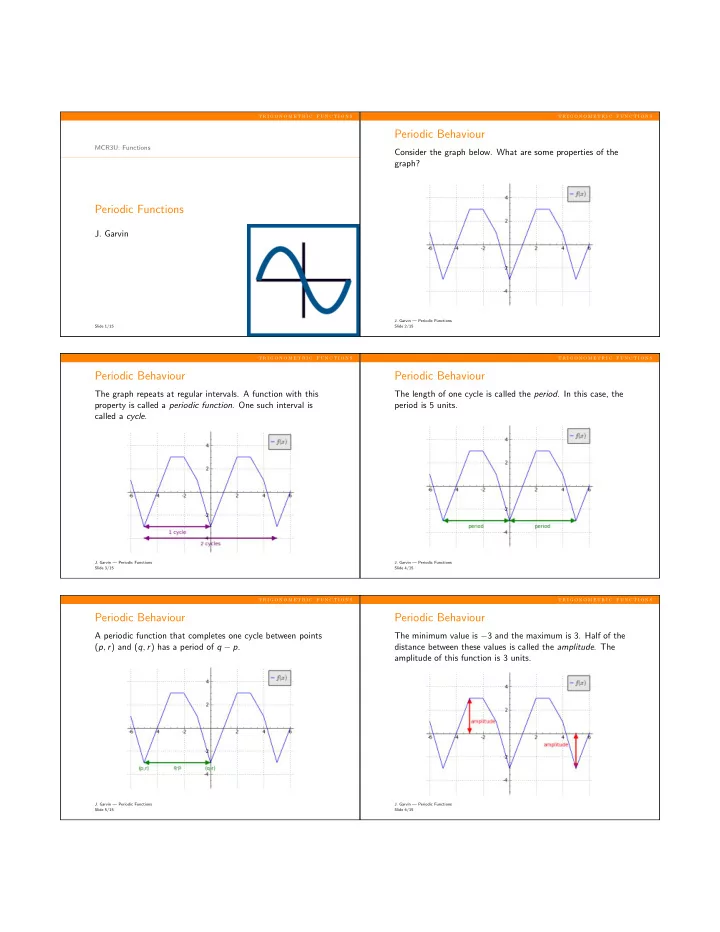

t r i g o n o m e t r i c f u n c t i o n s t r i g o n o m e t r i c f u n c t i o n s Periodic Behaviour MCR3U: Functions Consider the graph below. What are some properties of the graph? Periodic Functions J. Garvin J. Garvin — Periodic Functions Slide 1/15 Slide 2/15 t r i g o n o m e t r i c f u n c t i o n s t r i g o n o m e t r i c f u n c t i o n s Periodic Behaviour Periodic Behaviour The graph repeats at regular intervals. A function with this The length of one cycle is called the period . In this case, the property is called a periodic function . One such interval is period is 5 units. called a cycle . J. Garvin — Periodic Functions J. Garvin — Periodic Functions Slide 3/15 Slide 4/15 t r i g o n o m e t r i c f u n c t i o n s t r i g o n o m e t r i c f u n c t i o n s Periodic Behaviour Periodic Behaviour A periodic function that completes one cycle between points The minimum value is − 3 and the maximum is 3. Half of the ( p , r ) and ( q , r ) has a period of q − p . distance between these values is called the amplitude . The amplitude of this function is 3 units. J. Garvin — Periodic Functions J. Garvin — Periodic Functions Slide 5/15 Slide 6/15
t r i g o n o m e t r i c f u n c t i o n s t r i g o n o m e t r i c f u n c t i o n s Periodic Behaviour Periodic Behaviour Example A periodic function with minimum value ( a , b ) and maximum � � � b − d value ( c , d ) has an amplitude of � . For the function below, state the period and amplitude. 2 J. Garvin — Periodic Functions J. Garvin — Periodic Functions Slide 7/15 Slide 8/15 t r i g o n o m e t r i c f u n c t i o n s t r i g o n o m e t r i c f u n c t i o n s Periodic Behaviour Periodic Behaviour The function has a minimum value at ( − 3 , − 4) and again at The diagram below shows the period using both the (3 , − 4). minimum and maximum values. Since the function repeats after every minimum value, the period is 3 − ( − 3) = 6 units. Alternatively, the maximum values could be used instead. There is a maximum value at ( − 4 , 2) and another at (1 , 2). The point at (1 , 2), however, is not the point after which the function repeats. There is a small horizontal section that occurs first. Instead, use the point (2 , 2). This yields the same period of 2 − ( − 4) = 6 units. J. Garvin — Periodic Functions J. Garvin — Periodic Functions Slide 9/15 Slide 10/15 t r i g o n o m e t r i c f u n c t i o n s t r i g o n o m e t r i c f u n c t i o n s Periodic Behaviour Predictions Using Periodic Behaviour Since the minimum value of the function is − 4 and the Since a periodic function repeats regularly, it is possible to � � � = 3. � − 4 − 2 maximum is 2, the amplitude is predict values that may occur earlier or later. 2 For example, if a function had a period of 5 units, then f (0) = f (5) = f (10) = . . . = f (5 n ). Similarly, f (1) = f ( − 4) = f ( − 9) = . . . = f (1 − 5 n ). In each of these cases, the value of the period is repeatedly added or subtracted from a known value of the function. J. Garvin — Periodic Functions J. Garvin — Periodic Functions Slide 11/15 Slide 12/15
t r i g o n o m e t r i c f u n c t i o n s t r i g o n o m e t r i c f u n c t i o n s Predictions Using Periodic Behaviour Predictions Using Periodic Behaviour Example The period is 6, so we must add or subtract 6 until we reach a known value on the graph. For the function below, determine f (14), f ( − 19) and f (600). f (14) = f (6 + 6 + 2) = f (2) = 2. f ( − 19) = f ( − 1 − 6 − 6 − 6) = f ( − 1) = − 2. f (600) = f (6 × 100) = f (0 + 6 + 6 + . . . + 6 ) = f (0) = 0. � �� � 100 times J. Garvin — Periodic Functions J. Garvin — Periodic Functions Slide 13/15 Slide 14/15 t r i g o n o m e t r i c f u n c t i o n s Questions? J. Garvin — Periodic Functions Slide 15/15
Recommend
More recommend